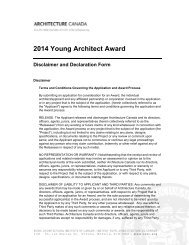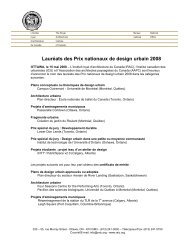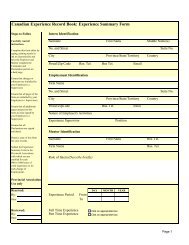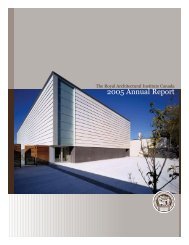Benchmark Study on Green Buildings - Royal Architectural Institute ...
Benchmark Study on Green Buildings - Royal Architectural Institute ...
Benchmark Study on Green Buildings - Royal Architectural Institute ...
Create successful ePaper yourself
Turn your PDF publications into a flip-book with our unique Google optimized e-Paper software.
Investment Fund (GIF), which is meant to help offset the incremental costs of green<br />
building projects in the Portland area which meet high levels of envir<strong>on</strong>mental<br />
performance through multi-faceted and innovative designs, progressive technologies, and<br />
best practices. Both public and private projects can apply for a total of $500,000 in aid<br />
available per year, with a maximum of $150,000 available per project. A 3:1 cost share<br />
ratio is required, meaning that a $90,000 package of approved green building and site<br />
measures may be eligible for a $30,000 GIF grant award. To date, the GIF has distributed<br />
nearly $1.5 milli<strong>on</strong> to developments dem<strong>on</strong>strating innovati<strong>on</strong> in green building<br />
technologies and practices in Portland.<br />
Renewable energy generator incentives:<br />
Incentive programs are also coming into place for buildings that use various new<br />
technologies to draw power from sustainable energy sources. For the first time in a<br />
generati<strong>on</strong>, the federal government will offer income tax credits for new solar energy<br />
installati<strong>on</strong>s. The Energy Act of 2005 also clears a major obstacle to decentralized<br />
electric producti<strong>on</strong> by amending existing law to require every public electric utility to<br />
offer net metering. This means that utilities must purchase power from small-scale<br />
electric producers, such as photovoltaic and wind. The new solar tax credit covers 30<br />
percent of the system cost up to $2,000, after taking into account state and utility<br />
incentives. Solar water heaters, except pool heaters, and photovoltaic systems installed in<br />
2006 and 2007 are eligible. Ariz<strong>on</strong>a and Oreg<strong>on</strong> have taken solar incentives a step further,<br />
with Ariz<strong>on</strong>a allowing residential customers who use solar power to receive a rebate of<br />
$4 per watt of solar electric power installed in a grid-tied applicati<strong>on</strong>, and $2 per watt<br />
installed in an off-grid applicati<strong>on</strong>. There is also a pers<strong>on</strong>al income tax credit for residents<br />
that install a photovoltaic power system <strong>on</strong> their property. This <strong>on</strong>e-time credit applies to<br />
both <strong>on</strong>- and off-grid residences and amounts to 25% of the system price or $1,000,<br />
whichever is less. Oreg<strong>on</strong> also raised its income tax credit for photovoltaic systems to an<br />
unprecedented $6,000 per installati<strong>on</strong>. Starting in 2006 and for the next 10 years, Oreg<strong>on</strong><br />
citizens who install photovoltaic systems can receive $3 per watt. The total credit is<br />
$6,000, but it can be taken <strong>on</strong>ly $1,500 per year over four years. The United States<br />
currently generates 156MW of solar energy, which translates to approximately 7% of the<br />
global total.<br />
Milli<strong>on</strong> Solar Roofs initiative & Solar America Initiative:<br />
The Milli<strong>on</strong> Solar Roofs Initiative (MSR) had the American nati<strong>on</strong>al government and<br />
various state governments teaming up to provide incentives to home owners for installing<br />
solar panels <strong>on</strong> their roofs. These rebates were approximately $2.80 per watt of<br />
generating power, and with the average home installing 3kW systems, the final result<br />
should have been an increase of about 3,000MW of solar generating power. However, the<br />
program was not finished as it was swept up into the Solar America Initiative (SAI). The<br />
goal of the SAI is to accelerate the development of advanced solar electric technologies,<br />
including photovoltaics and c<strong>on</strong>centrating solar power systems, with the goal of making<br />
them cost-competitive with other forms of renewable electricity by 2015. The SAI has a<br />
budget of $148 milli<strong>on</strong> and will c<strong>on</strong>tinue with the MSR installati<strong>on</strong> incentives, as well as<br />
fund photovoltaic and solar power R&D at universities, government laboratories, and in<br />
the industry. Although the MSR incentives are the <strong>on</strong>ly part of the SAI currently in acti<strong>on</strong>,<br />
44

















